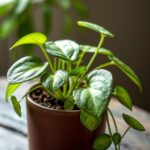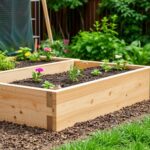Is It Okay to Put Styrofoam in the Bottom of a Planter? Exploring the Benefits and Risks

When it comes to gardening, the choice of materials used in planters can significantly affect plant health and growth. One common practice is placing Styrofoam in the bottom of pots to enhance drainage and reduce soil usage. However, this approach raises questions about its overall impact on the environment and plant vitality. In this article, we will explore the benefits and risks associated with using Styrofoam as a planter filler. By understanding the implications, gardeners can make informed decisions that balance practicality with ecological responsibility, ensuring a thriving garden while considering sustainable practices.
Is Putting Styrofoam at the Bottom of a Planter a Good Idea?
Using styrofoam at the bottom of a planter can offer certain benefits, particularly in terms of reducing weight and improving drainage. While it is generally acceptable to use styrofoam as a base layer, it's important to consider its environmental impact and potential long-term effects on soil quality. Styrofoam does not decompose, which means it may remain in the planter for many years, possibly affecting plant growth and health. Additionally, when using styrofoam, ensure that it is clean and free from any chemicals or residues that could harm your plants.
Benefits of Using Styrofoam in Planters
One of the primary benefits of using styrofoam in planters is its ability to help with drainage. By creating a layer that allows excess water to escape, styrofoam can prevent root rot and other moisture-related issues. Additionally, it can lighten the overall weight of the planter, making it easier to move. This is especially beneficial for larger containers that would otherwise be heavy and cumbersome.
Environmental Impact of Styrofoam
Styrofoam is made from polystyrene, which is a non-biodegradable material. Its use in gardening can contribute to environmental pollution if not disposed of properly. Styrofoam can take hundreds of years to decompose in landfills, releasing harmful chemicals during that process. Gardeners should consider eco-friendly alternatives such as recycled materials or natural fillers, as these options can mitigate the environmental impact associated with traditional styrofoam.
Alternatives to Styrofoam for Planters
There are several alternatives to styrofoam that can help with drainage and reduce weight in planters. Materials such as rocks, gravel, or even biodegradable options like coconut coir can serve as effective substitutes. Using these alternatives not only supports better drainage but also contributes positively to soil health, as they can decompose over time and enhance soil structure.
See also:
Potential Issues with Styrofoam in Gardening
Although using styrofoam can aid in drainage, it may pose certain risks. Over time, styrofoam can break down into smaller particles, potentially leading to soil contamination. These microplastics can adversely impact plant health and soil microorganisms. Additionally, if the styrofoam is not adequately cleaned, it may introduce harmful substances that can impede plant growth.
How to Properly Use Styrofoam in Planters
If you choose to use styrofoam in your planters, it is crucial to do so wisely. Start with a clean, intact styrofoam layer at the base of the planter to promote drainage. Ensure that the styrofoam is not in direct contact with the soil, as this can lead to soil compaction. Moreover, monitor the planter's condition regularly, checking for any adverse effects on plant health.
| Material | Advantages | Disadvantages |
|---|---|---|
| Styrofoam | Lightweight, good drainage | Non-biodegradable, potential contaminants |
| Gravel | Natural drainage, biodegradable | Heavier than styrofoam |
| Coconut Coir | Biodegradable, good moisture retention | May need to be replaced regularly |
| Rocks | Durable, enhances drainage | Heavy, may compact soil |
Understanding the Environmental Impact of Styrofoam in Planters
Using styrofoam in the bottom of a planter has gained popularity among gardeners looking for ways to reduce the weight of their potted plants and improve drainage. While this practice can offer benefits such as enhanced aeration and preventing soil from escaping the drainage holes, it brings with it a significant environmental concern. Styrofoam is not biodegradable and can contribute to pollution if it breaks down into microplastics. Moreover, the presence of chemicals in styrofoam raises questions about their potential leaching into soil and plants, impacting both plant health and the surrounding ecosystem. Therefore, understanding the balance between its benefits and environmental risks is crucial for responsible gardening.
Benefits of Using Styrofoam in Planters
One primary advantage of using styrofoam in planters is its lightweight nature, which makes it easier to move larger plants without the burden of heavy soil. Additionally, styrofoam can significantly improve drainage by creating space for excess water to flow away from the roots, potentially reducing issues related to root rot. Its insulating properties can also help maintain a more stable soil temperature, protecting the roots from extreme heat or cold fluctuations. Gardeners often report that this practice allows for healthier plants and a more manageable gardening experience.
Risks Associated with Styrofoam Usage
While there are benefits, the use of styrofoam also poses several risks. One major concern is the potential for chemical leaching; some styrofoam products may contain harmful additives that could leach into the soil over time. This could adversely affect plant growth and potentially enter the food chain. Furthermore, styrofoam is a non-renewable resource, and its use contributes to environmental pollution, as it is not biodegradable and can take hundreds of years to decompose. The aesthetic implications of visible styrofoam in planters can also be undesirable for many gardeners.
See also:
Alternatives to Styrofoam in Planters
Gardeners seeking eco-friendly alternatives can consider using recycled materials such as crushed cans, bottles, or even biodegradable options like coconut coir. These substitutes can help improve drainage while minimizing environmental impact. Additionally, using rocks or pebbles at the bottom of the planter can provide weight and drainage without contributing to pollution. Organic materials like bark or mulch can also offer adequate support and proper aeration to the plant's roots, fostering a healthier growing environment while being more sustainable.
The Role of Styrofoam in Gardening Techniques
Styrofoam can play a unique role in specific gardening techniques, such as container gardening and raised beds. In container gardening, it helps reduce soil compaction and improves water movement, which can be particularly beneficial for potted plants that require quick drainage. In raised beds, a layer of styrofoam can create better drainage layers, especially in regions with high rainfall. However, employing these techniques should always involve an assessment of the long-term impact on both the plants and the environment to ensure responsible gardening practices.
Best Practices for Using Styrofoam in Planters
If gardeners choose to use styrofoam, adhering to best practices is crucial. It’s recommended to break the styrofoam into smaller pieces to promote better drainage and reduce the chances of large chunks obstructing flow. For those concerned about aesthetics, covering the styrofoam with a layer of soil or decorative stones can help disguise it while still allowing it to serve its function. Regular monitoring of plant health is essential as well, ensuring that there are no adverse effects from the materials used and promoting a thriving garden environment.
Questions from Our Readers
Is it okay to put styrofoam in the bottom of a planter?
Yes, it is generally okay to put styrofoam in the bottom of a planter. It can help improve drainage and reduce the overall weight of the planter. However, be cautious, as styrofoam does not biodegrade and can contribute to environmental issues if not disposed of properly.
Will using styrofoam affect plant growth?
Using styrofoam in a planter will not directly affect plant growth as long as it is used correctly. It serves primarily as a drainage layer, preventing soil from blocking the drainage holes. Just ensure the top layer contains nutrient-rich soil to support healthy plant growth.
See also:
What are the alternatives to styrofoam for drainage in planters?
Alternatives to styrofoam for creating drainage in planters include rocks, gravel, or even broken pottery. These materials can also provide sufficient drainage while being more eco-friendly and avoiding the plastic pollution associated with styrofoam.
Can styrofoam be recycled after use in planters?
Styrofoam can be recycled, but the process is not as straightforward as other materials. Many local recycling programs do not accept styrofoam, so it's important to check your local guidelines. Alternatively, consider reusing it in creative projects or finding a specialized recycling facility for proper disposal.

If you want to read more articles like Is It Okay to Put Styrofoam in the Bottom of a Planter? Exploring the Benefits and Risks, we recommend you check out our Planter category.
Leave a Reply
Related Articles